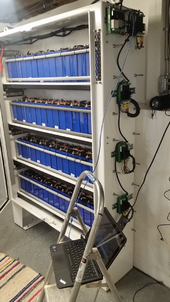Certainly not for everyone but economy of scale can make a huge difference. Most here do one-off battery builds, that isn't how to do it. You want to build large and have each part repeated several times.
Take for instance my bank.

The box was sourced used and on the cheap for $200. I didn't have to build an enclosure. Each shelf is the same length and width. While it takes some tools to build those shelves such as a welder and saw to cut steel, you probably shouldn't be attempting a build without some equipment. BMS is a Batrium and that does kill some time as each balance lead is fused. However, once I mounted the first K9 and determined wire length, I could cut all the wires for the remaining harnesses that needed to be built. Compression fixtures are all the same, once a pattern for the end plate is made, then cutting and drilling all remaining plates is easy. Each plate was used as a fixture to drill holes in the end, then the rod length and insulating pvc cover length was determined, all cut at the same time. Even cutting the Poron placed between cells was done in an assembly line process, first a pattern, then used a paper cutter to cut the remaining with a big stack of cut sheets all done in a short time.
Busbars used between cells are just the factory tinned copper supplied with the cells. With 4 batteries, the load on each battery will never be enough to exceed the capacity of the busbars. On the ends, the Class T fuses were all mounted the same and the connecting busbars were the same. Again, assembly line process.
Did I spend some time doing all of this? I certainly did, an hour or two in the evening, some weekends. I ended up with a 58 Kwh battery at $11K and could have dropped off $2K easily by not using the Batrium. I'm currently getting ready to build another 4 battery bank for the shop and it will come in much cheaper as cell prices have dropped and I'm using JK's this time so no need for the ABB shunt trip breaker either. At the time I built this, the offerings out there were server rack 100Ah batteries and would have cost about $16K plus shipping for the same size bank (my cost included all shipping). The shop bank will be 57 Kwh and final cost should be around $8K or less due to the drop in cell prices and using the JK's. Cells only cost under $6K shipped to my door. I see the EG4 Power Pro is currently on sale and to equal that size for the bank would run about $16.4K to my door.
Can I build a bank like this for $8K for my labor? I do know this second build will take less time as I already have a pattern of how to do it, so averaging the 2 builds out comes out to some decent money for my time. I always look for a gross profit of $100/hour for any work I do. Fabrication isn't for everyone, it takes some skills and fine tuning those skills over time. I've been building things from scratch since I was about 12 years old so that gives me 45 years of experience to have an idea, form a plan and implementing it. Each section needs to be broken into several parts, otherwise you will find yourself overwhelmed. One needs to plan 10 steps ahead. I don't write this down on paper either, all of it based upon the blueprint in my mind. It's a gift some have and some don't. For those that do, it can be quite rewarding. Some can accomplish it by drawing a design and working off it. And some can't beat their way out of a wet paper bag. It isn't for everyone. Some may be willing to accept certain tradeoffs to achieve a result such as no compression, just using an open shelf for holding cells. Nothing wrong with that approach as long as the end result is safe and works.



